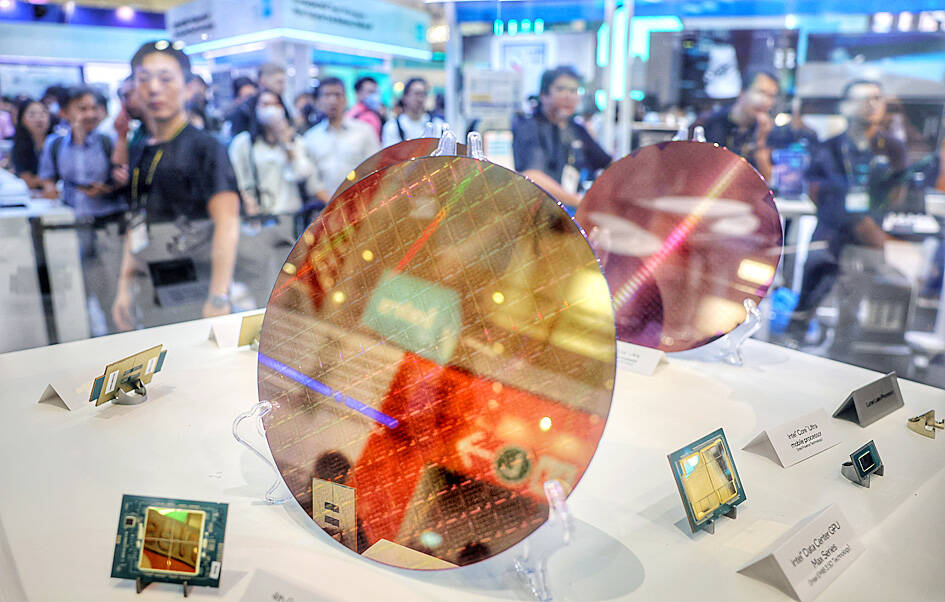Taiwan should collaborate with trusted partners to maintain its edge in advanced semiconductor manufacturing, while also confronting China’s increasing global share of legacy chip production, a panel of experts told a forum in Taipei yesterday.
While Taiwan enjoys a “strong and capable” ecosystem in advanced semiconductor manufacturing, it needs to continue working with global partners to “build up the alliance [and] interconnections,” former US security official Joe Wang said.
Additionally, Taiwan should collaborate with those partners on boosting the production of legacy chips, Wang said, referring to less advanced semiconductors that are used in household appliances and automobiles, among others.

Photo: CNA
Global legacy chipmaking has increasingly become “skewed toward China,” Wang said, adding that the situation was “extremely concerning.”
The Chinese government has subsidized production of legacy chips “in a way that none of the rest of our countries can do,” adding that such an approach was not business-driven, but aimed at expanding Beijing’s political influence, Wang said.
Cooperation between trusted partners is needed to balance China’s competitiveness in manufacturing legacy chips, also known as mature nodes, he added.
Wang, who spoke in his capacity as a senior advisor at the Virginia-based think tank Special Competitive Studies Project, previously served as the US National Security Council’s director for Russia.
His comments echoed those of US Secretary of Commerce Gina Raimondo, who in April said that China was producing about 60 percent of legacy chips in the world and would continue to do so in the coming years.
The surge in Chinese production was partly caused by US-led export bans on advanced chips and chipmaking equipment to China on national security grounds, some observers said.
Sharing Wang’s concerns, Institute of Geoeconomics director Kazuto Suzuki cautioned against complacency and underscored prioritizing the maintenance of “technological superiority.”
“We cannot just sit and relax,” he said.
China was also striving to make advanced chips, despite facing restricted access to those that power artificial intelligence and other cutting-edge technologies, Suzuki added.
Suzuki urged Japan and Taiwan to further explore collaboration opportunities for semiconductor research and development, such as facilitating the exchanges of technologies, ideas and people.
“Friendshoring is not just about production and trade,” he said. “Friendshoring is also about how to share the information, how to share intellectual property [and] how to maintain those movements of people.”
The Japanese expert was alluding to an emerging trend in trade where supply chain networks prioritize countries seen as political and economic partners.
South Korean economist Yeon Won-ho, a member of the South Korean Presidential Office’s policy advisory committee, also called for cooperation between his country and Taiwan, saying that the two were not “competitors,” but were “complementary” to each other.
One key area for possible collaboration between Taiwan and South Korea is information and communication technology services and devices, Yeon said.
This represents an emerging market, Yeon said, particularly as the US government seeks to ban Chinese-made communications and automated driving systems in cars for fear of data collection by Chinese companies.
The forum was co-organized by the Research Institute for Democracy, Society and Emerging Technology, a national think tank established in October last year under Taiwan’s National Science and Technology Council.

SHIPS, TRAINS AND AUTOMOBILES: The ministry has announced changes to varied transportation industries taking effect soon, with a number of effects for passengers Beginning next month, the post office is canceling signature upon delivery and written inquiry services for international registered small packets in accordance with the new policy of the Universal Postal Union, the Ministry of Transportation and Communications said yesterday. The new policy does not apply to packets that are to be delivered to China, the ministry said. Senders of international registered small packets would receive a NT$10 rebate on postage if the packets are sent from Jan. 1 to March 31, it added. The ministry said that three other policies are also scheduled to take effect next month. International cruise ship operators

NUMBERS IMBALANCE: More than 4 million Taiwanese have visited China this year, while only about half a million Chinese have visited here Beijing has yet to respond to Taiwan’s requests for negotiation over matters related to the recovery of cross-strait tourism, the Tourism Administration said yesterday. Taiwan’s tourism authority issued the statement after Chinese-language daily the China Times reported yesterday that the government’s policy of banning group tours to China does not stop Taiwanese from visiting the country. As of October, more than 4.2 million had traveled to China this year, exceeding last year. Beijing estimated the number of Taiwanese tourists in China could reach 4.5 million this year. By contrast, only 500,000 Chinese tourists are expected in Taiwan, the report said. The report

The Forestry and Nature Conservation Agency yesterday launched a gift box to market honey “certified by a Formosan black bear” in appreciation of a beekeeper’s amicable interaction with a honey-thieving bear. Beekeeper Chih Ming-chen (池明鎮) in January inspected his bee farm in Hualien County’s Jhuosi Township (卓溪) and found that more than 20 beehives had been destroyed and many hives were eaten, with bear droppings and paw prints near the destroyed hives, the agency said. Chih returned to the farm to move the remaining beehives away that evening when he encountered a Formosan black bear only 20m away, the agency said. The bear

Chinese embassy staffers attempted to interrupt an award ceremony of an international tea competition in France when the organizer introduced Taiwan and displayed the Republic of China flag, a Taiwanese tea farmer said in an interview published today. Hsieh Chung-lin (謝忠霖), chief executive of Juxin Tea Factory from Taichung's Lishan (梨山) area, on Dec. 2 attended the Teas of the World International Contest held at the Peruvian embassy in Paris. Hsieh was awarded a special prize for his Huagang Snow Source Tea by the nonprofit Agency for the Valorization of Agricultural Products (AVPA). During the ceremony, two Chinese embassy staffers in attendance